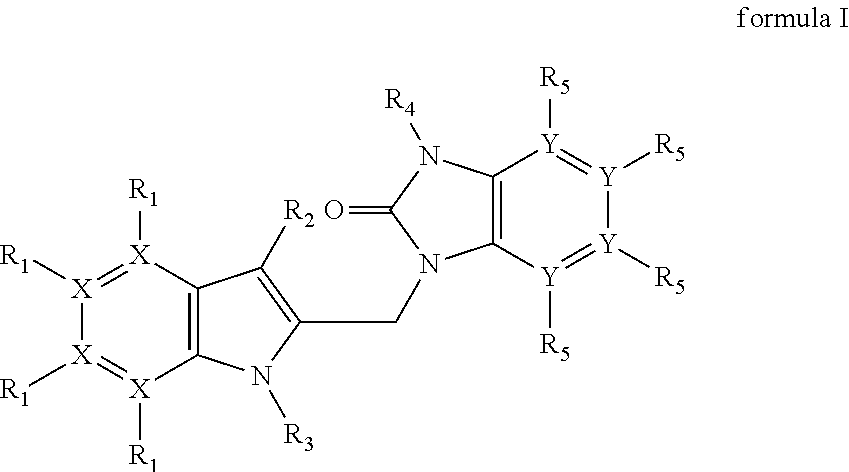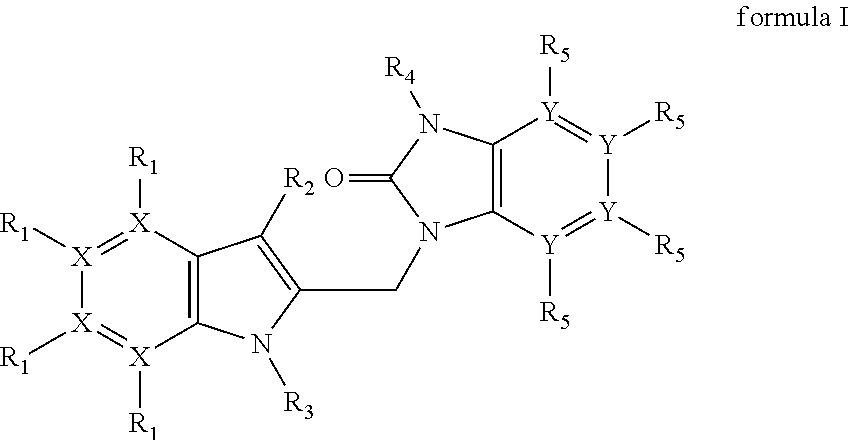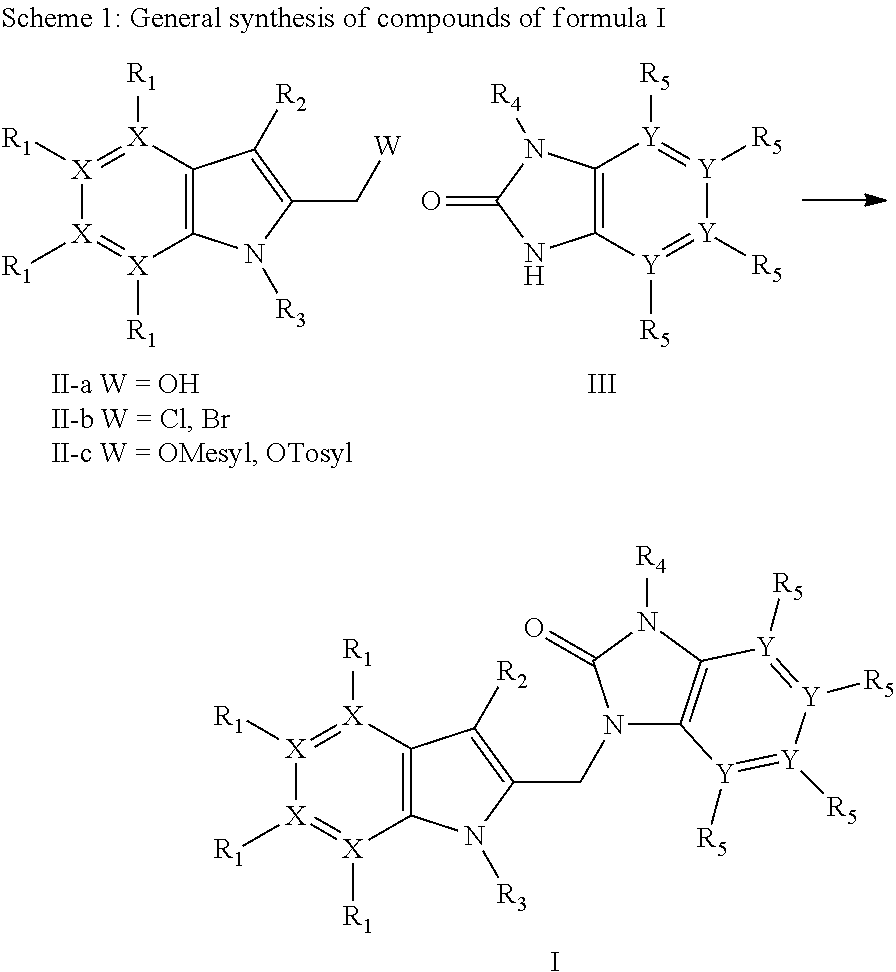Azaindoles as respiratory syncytial virus antiviral agents
a technology of respiratory syncytial virus and azaindole, which is applied in the field of azaindole having antiviral activity, can solve the problems of increased susceptibility, significant mortality, and infection with a virus from a given subgroup that does not pro
- Summary
- Abstract
- Description
- Claims
- Application Information
AI Technical Summary
Benefits of technology
Problems solved by technology
Method used
Image
Examples
example 1
[0098]A detailed description of the synthesis of a representative example of the invention, compound P1 is given below.
Step 1: Synthesis of N-cyclopropyl-3-nitropyridin-4-amine (5-b)
[0099]4-Methoxy-3-nitropyridine 5-a (CAS 31872-62-5) (200 g, 1300 mmol), cyclopropyl-amine (CAS 765-30-0) (185.5 g, 3250 mmol) and DIEA (CAS 7087-68-5) (336 g, 2600 mmol) in dry ethanol (800 mL) was refluxed for 3 hours. The mixture was cooled to 0° C. The solid was collected by filtration. The filter cake was washed with cold ethanol (150 mL). The solid was dried to afford compound 5-b as a white powder (167 g, 72%).
Step 2: Synthesis of N4-cyclopropylpyridine-3,4-diamine (5-c)
[0100]A mixture of the intermediate 5-b (167 g, 932 mmol) in ethanol (1400 mL) was hydrogenated (50 Psi) at 20° C. with wet 10% Pd / C (34 g) as a catalyst overnight. After uptake of H2 (3 eq.), the catalyst was filtered off and the filtrate was evaporated. The residue was washed with MTBE to afford compound 5-c as a yellow powder (1...
example 1a
[0110]
Step 1: synthesis of ethyl 3-(2-chloro-5-nitropyridin-4-yl)-2-oxopropanoate 10-a
[0111]To a solution of 2-Chloro-4-methyl-5-nitropyridine (20 g, 115 mmoles) in diethyl oxalate (150 mL) under a nitrogen atmosphere was added DBU (20 mL, 1.15 eq) dropwise and stirring at room temperature was continued overnight. The reaction mixture was then poured into 200 mL ice water and this mixture was acidified with 140 mL 1N HCl solution. The semi solids were allowed to fall out and the solvent on top of it was decanted off. The residue was then stirred in ice cold ethanol. The precipitate was filtered off and dried in vacuo to give 29.04 g (92% yield) of the targeted compound 10-a. m / z=273 (M+H)+; 1H NMR (400 MHz, DMSO-d6) TM ppm 1.30 (t, J=7.0 Hz, 3H), 4.32 (q, J=7.1 Hz, 2H), 4.68 (s, 2H), 6.68 (s, 1H), 7.80 (s, 1H), 8.25 (s, 1H), 9.00 (s, 1H), 9.14 (s, 1H).
Step 2: synthesis of ethyl 5-chloro-1H-pyrrolo[2,3-c]pyridine-2-carboxylate 10-b
[0112]To a solution of ethyl 3-(2-chloro-5-nitropyrid...
example 1b
[0115]
Step 1: synthesis of 2-bromo-6-chloropyridin-3-amine 11-a
[0116]Bromine (24.86 g, 155.57 mmol) was added to a solution of 6-chloropyridin-3-amine (20.00 g, 155.57 mmol) and sodium acetate (25.52 g, 311.14 mmol) in acetic acid (383 ml). The reaction mixture was stirred at room temperature for 1 hour. Acetic acid was then evaporated. The residue was dissolved in EtOAc, washed with saturated aqueous Na2CO3, water and brine. The organic layer was dried over MgSO4, filtered and evaporated, yielding 32.20 g of the desired product 11-a (99.8%). m / z=206.96 (M+H)+, Cl+Br pattern.
Step 2: synthesis of 5-chloro-1H-pyrrolo[3,2-b]pyridine-2-carboxylic acid 11-b
[0117]2-oxopropanoic acid (36.22 g, 411.31 mmol), palladium(II)acetate (7.74 g, 34.15 mmol) and Et3N (69.11 g, 682.94 mmol) were added to a solution of 2-bromo-6-chloropyridin-3-amine 11-a (32.20 g, 155.21 mmol) and TPP (35.83 g, 136.59 mmol) in dry DMF (300 ml). The reaction mixture was stirred at 100° C. overnight. The solvent was th...
PUM
| Property | Measurement | Unit |
|---|---|---|
| Mass | aaaaa | aaaaa |
| Mass | aaaaa | aaaaa |
| Molar density | aaaaa | aaaaa |
Abstract
Description
Claims
Application Information
 Login to View More
Login to View More - R&D
- Intellectual Property
- Life Sciences
- Materials
- Tech Scout
- Unparalleled Data Quality
- Higher Quality Content
- 60% Fewer Hallucinations
Browse by: Latest US Patents, China's latest patents, Technical Efficacy Thesaurus, Application Domain, Technology Topic, Popular Technical Reports.
© 2025 PatSnap. All rights reserved.Legal|Privacy policy|Modern Slavery Act Transparency Statement|Sitemap|About US| Contact US: help@patsnap.com



